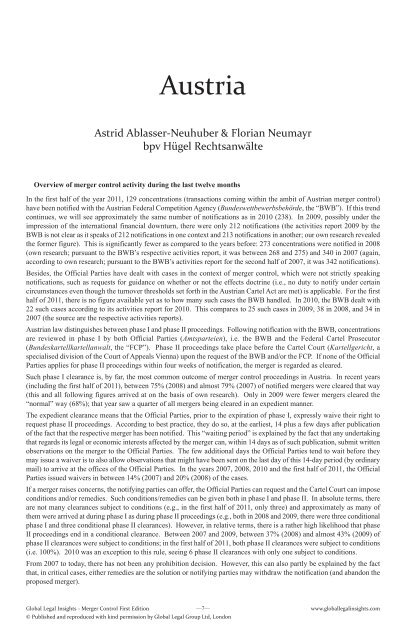Merger Controls First Edition - J Sagar Associates
Merger Controls First Edition - J Sagar Associates
Merger Controls First Edition - J Sagar Associates
You also want an ePaper? Increase the reach of your titles
YUMPU automatically turns print PDFs into web optimized ePapers that Google loves.
Austria<br />
Astrid AblasserNeuhuber & Florian Neumayr<br />
bpv Hügel Rechtsanwälte<br />
Overview of merger control activity during the last twelve months<br />
In the first half of the year 2011, 129 concentrations (transactions coming within the ambit of Austrian merger control)<br />
have been notified with the Austrian Federal Competition Agency (Bundeswettbewerbsbehörde, the “BWB”). If this trend<br />
continues, we will see approximately the same number of notifications as in 2010 (238). In 2009, possibly under the<br />
impression of the international financial downturn, there were only 212 notifications (the activities report 2009 by the<br />
BWB is not clear as it speaks of 212 notifications in one context and 213 notifications in another; our own research revealed<br />
the former figure). This is significantly fewer as compared to the years before: 273 concentrations were notified in 2008<br />
(own research; pursuant to the BWB’s respective activities report, it was between 268 and 275) and 340 in 2007 (again,<br />
according to own research; pursuant to the BWB’s activities report for the second half of 2007, it was 342 notifications).<br />
Besides, the Official Parties have dealt with cases in the context of merger control, which were not strictly speaking<br />
notifications, such as requests for guidance on whether or not the effects doctrine (i.e., no duty to notify under certain<br />
circumstances even though the turnover thresholds set forth in the Austrian Cartel Act are met) is applicable. For the first<br />
half of 2011, there is no figure available yet as to how many such cases the BWB handled. In 2010, the BWB dealt with<br />
22 such cases according to its activities report for 2010. This compares to 25 such cases in 2009, 38 in 2008, and 34 in<br />
2007 (the source are the respective activities reports).<br />
Austrian law distinguishes between phase I and phase II proceedings. Following notification with the BWB, concentrations<br />
are reviewed in phase I by both Official Parties (Amtsparteien), i.e. the BWB and the Federal Cartel Prosecutor<br />
(Bundeskartellkartellanwalt, the “FCP”). Phase II proceedings take place before the Cartel Court (Kartellgericht, a<br />
specialised division of the Court of Appeals Vienna) upon the request of the BWB and/or the FCP. If none of the Official<br />
Parties applies for phase II proceedings within four weeks of notification, the merger is regarded as cleared.<br />
Such phase I clearance is, by far, the most common outcome of merger control proceedings in Austria. In recent years<br />
(including the first half of 2011), between 75% (2008) and almost 79% (2007) of notified mergers were cleared that way<br />
(this and all following figures arrived at on the basis of own research). Only in 2009 were fewer mergers cleared the<br />
“normal” way (68%); that year saw a quarter of all mergers being cleared in an expedient manner.<br />
The expedient clearance means that the Official Parties, prior to the expiration of phase I, expressly waive their right to<br />
request phase II proceedings. According to best practice, they do so, at the earliest, 14 plus a few days after publication<br />
of the fact that the respective merger has been notified. This “waiting period” is explained by the fact that any undertaking<br />
that regards its legal or economic interests affected by the merger can, within 14 days as of such publication, submit written<br />
observations on the merger to the Official Parties. The few additional days the Official Parties tend to wait before they<br />
may issue a waiver is to also allow observations that might have been sent on the last day of this 14-day period (by ordinary<br />
mail) to arrive at the offices of the Official Parties. In the years 2007, 2008, 2010 and the first half of 2011, the Official<br />
Parties issued waivers in between 14% (2007) and 20% (2008) of the cases.<br />
If a merger raises concerns, the notifying parties can offer, the Official Parties can request and the Cartel Court can impose<br />
conditions and/or remedies. Such conditions/remedies can be given both in phase I and phase II. In absolute terms, there<br />
are not many clearances subject to conditions (e.g., in the first half of 2011, only three) and approximately as many of<br />
them were arrived at during phase I as during phase II proceedings (e.g., both in 2008 and 2009, there were three conditional<br />
phase I and three conditional phase II clearances). However, in relative terms, there is a rather high likelihood that phase<br />
II proceedings end in a conditional clearance. Between 2007 and 2009, between 37% (2008) and almost 43% (2009) of<br />
phase II clearances were subject to conditions; in the first half of 2011, both phase II clearances were subject to conditions<br />
(i.e. 100%). 2010 was an exception to this rule, seeing 6 phase II clearances with only one subject to conditions.<br />
From 2007 to today, there has not been any prohibition decision. However, this can also partly be explained by the fact<br />
that, in critical cases, either remedies are the solution or notifying parties may withdraw the notification (and abandon the<br />
proposed merger).<br />
Global Legal Insights <strong>Merger</strong> Control <strong>First</strong> <strong>Edition</strong><br />
—7—<br />
© Published and reproduced with kind permission by Global Legal Group Ltd, London<br />
www.globallegalinsights.com


